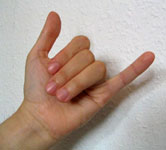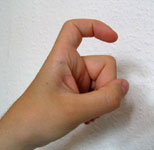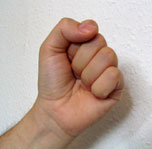It seems like a question with an obvious answer. You have five fingers after all. But there are ways to go beyond a simple counting of fingers. So, what is actually the highest number we can count using only one hand?
Five
Let’s start with the method everyone knows. Hold up as many fingers as you want. As everyone with basic counting skills knows, this lets you count up to five. Depending on where you from, the way you hold up your fingers might be different. This was a major plot point in Inglorious Basterds in which a British spy gives himself away to the Nazis by using the wrong gesture.
Perhaps the most different system I’ve come across is in Japan, where they will hold up all fingers to indicate ‘zero’ then, starting with the thumb, lower each finger to indicate 1, 2, and finally indicate 5 with a closed fist. This could be confusing to people outside the country, since they would be holding up three fingers to indicate ‘2’.
But can we have a system that would allow us to indicate numbers greater than 5?
25 – 1
As a programmer I’m often exposed to binary numbers. These are numbers that use only two digits (1 and 0), instead of the ten digits we normally use. Otherwise they work the same as regular numbers. As an example, counting to five in binary looks like this:
0, 1, 10, 11, 100, 101
Each extra digit can be thought to have a value of the previous times 2. In our usual number system we multiply by ten, giving us 10 with a value of, well, ten, 100 with a value one hundred. Very tautological. But in binary, 10 has a value of 2 (i.e. 2×1), 100 has a value of 4 (2×2), 1000 has a value of 8 (2×4), and so on.
If we use 5 digits the values of each would look like this:
| 16 | 8 | 4 | 2 | 1 | 1 1 1 1 1
So, what if we had each finger represent a binary digit? We could have the thumb represent 1, the index finger 2, the middle finger 4, all the way up to the little finger at 16.
This way, if we wanted to say one (00001), we hold up only the thumb. For two (00010) we hold up the index finger. For three (00011) we hold up the index finger and the thumb.
Using this method we can represent numbers up to 31 using only one hand. So much better than the “count-the-numbers” system. Right?
Well, not really. There are some glaring issues with this system.
First, if you’re confused by binary numbers, you’re not alone. Adopting this system would require everyone to get used to binary numbers, and they don’t pop up in real life enough for people in general to get used to them.
Second, it’s easy to confuse this system with the more common “count-the-fingers” method. If I’m holding up three fingers, do I mean 3 or 7 or 14?
Third, some combinations of fingers are hard to hold up (for me at least). So there may be some numbers people couldn’t even indicate because their hands simply don’t bend that way.
Having to go through the process of converting a number to binary, figure out what fingers to hold up, and then hoping you can actually make that gesture isn’t going to be intuitive for most people.
But there is already a much better system, that can count even higher than this. And it is used by at least 1/6 of the people on the planet.
China
In China they have hand gestures for the numbers six to ten that you see all the time if you live in the country. You can learn them very quickly, and it doesn’t take long for them to become instinct. Even after leaving China I’ll subconsciously make a hand gesture when talking about numbers.
According to the Wikipedia article on Chinese hand gestures there are actually some regional variants, but the ones I got used to using are the ones below:





But this only gets us up to ten and I mentioned this system could count higher than the binary system. Well, the trick is that you can make multiples of these hand gestures in quick succession to indicate higher numbers. So to make the number 42 (四十二), you would first make the hand gesture for “four”, followed quickly by “ten”, then “two”.
Using this method, you can count up to 99 on one hand. It’s easy to learn, and works in base-10. A vast improvement over the binary gesture system.
Unfortunately you can’t count past 99 with this system, since there is no hand gesture for 100 (百). But it’s still the best system I’ve discovered so far.
Conclusion
While researching this article, I came across different ways of counting in various cultures. These include Japanese Finger Counting, and Senary Finger Counting that uses base-6 numbers. However, both of these systems use two hands, so I didn’t include them.
It has gotten me curious though. Not many people outside of China and Taiwan are aware of the finger gestures used there, and I wonder if there are any other obscure systems out there. If you know of any, then let me know in the comments below.




